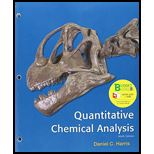
Concept explainers
(a)
Interpretation:
The cathode potential at which
Concept Introduction:
When the
E(cathode) is electrode’s potential which is attached to negative terminal of current source.
E(anode) is electrode’s potential which is attached to positive terminal of current source.
Concentration Polarization: It is the change in concentration of products and reactants at electrode’s surface unlike they are same in solution.
(a)
Answer to Problem 17.BE
The cathode potential at which
Explanation of Solution
To determine: The cathode potential at which
(b)
Interpretation:
The percentage of
Concept Introduction:
When the electric current is too small, the voltage of cell is given as
E(cathode) is electrode’s potential which is attached to negative terminal of current source.
E(anode) is electrode’s potential which is attached to positive terminal of current source.
Concentration Polarization: It is the change in concentration of products and reactants at electrode’s surface unlike they are same in solution.
(b)
Answer to Problem 17.BE
The percentage of
Explanation of Solution
To determine: The percentage of
The concentration of copper ion equilibrium with copper at
The percentage of copper ion not reduced is determined as
Want to see more full solutions like this?
Chapter 17 Solutions
Quantitative Chemical Analysis:
 ChemistryChemistryISBN:9781305957404Author:Steven S. Zumdahl, Susan A. Zumdahl, Donald J. DeCostePublisher:Cengage Learning
ChemistryChemistryISBN:9781305957404Author:Steven S. Zumdahl, Susan A. Zumdahl, Donald J. DeCostePublisher:Cengage Learning ChemistryChemistryISBN:9781259911156Author:Raymond Chang Dr., Jason Overby ProfessorPublisher:McGraw-Hill Education
ChemistryChemistryISBN:9781259911156Author:Raymond Chang Dr., Jason Overby ProfessorPublisher:McGraw-Hill Education Principles of Instrumental AnalysisChemistryISBN:9781305577213Author:Douglas A. Skoog, F. James Holler, Stanley R. CrouchPublisher:Cengage Learning
Principles of Instrumental AnalysisChemistryISBN:9781305577213Author:Douglas A. Skoog, F. James Holler, Stanley R. CrouchPublisher:Cengage Learning Organic ChemistryChemistryISBN:9780078021558Author:Janice Gorzynski Smith Dr.Publisher:McGraw-Hill Education
Organic ChemistryChemistryISBN:9780078021558Author:Janice Gorzynski Smith Dr.Publisher:McGraw-Hill Education Chemistry: Principles and ReactionsChemistryISBN:9781305079373Author:William L. Masterton, Cecile N. HurleyPublisher:Cengage Learning
Chemistry: Principles and ReactionsChemistryISBN:9781305079373Author:William L. Masterton, Cecile N. HurleyPublisher:Cengage Learning Elementary Principles of Chemical Processes, Bind...ChemistryISBN:9781118431221Author:Richard M. Felder, Ronald W. Rousseau, Lisa G. BullardPublisher:WILEY
Elementary Principles of Chemical Processes, Bind...ChemistryISBN:9781118431221Author:Richard M. Felder, Ronald W. Rousseau, Lisa G. BullardPublisher:WILEY





